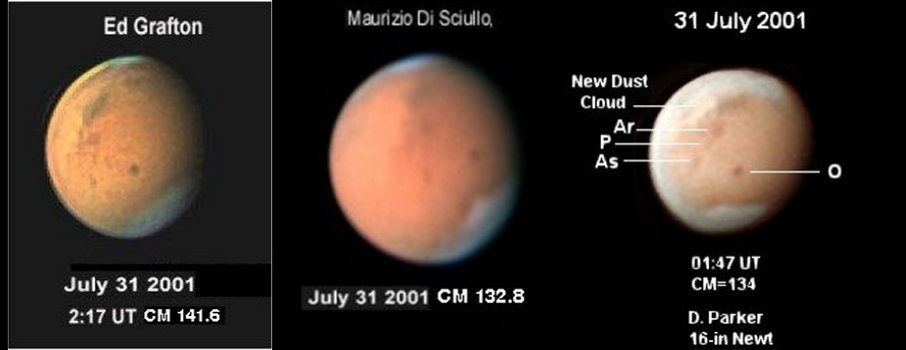
INTRODUCTION
It was Ray Bradbury who wrote of the "Sand Ships of Mars" in his science fiction novel, The Martian Chronicles (Bradbury, 1950). One can imagine the fictional inhabitants of Mars trekking across its deserts in their floating machines stirring up huge dust devils. This great science fiction story set the stage for this author’s interest in Mars and who now writes about similar accounts of the real dusty whirlwinds on the Red Planet. [NOTE: see Mars Chart in Reference secton for location names].
One of the most spectacular events to watch in our Solar System is the development of a major Martian dust storm. From Earth a Martian dust cloud may seem to be just a nuisance to any would-be telescopic explorer on that planet. However, if you consider the actual size of these clouds then you suddenly realize that many of them would cover entire western United States! Imagine if a Mars-sized planet-encircling dust storm would occur on Earth; it would blank out most of an entire Hemisphere!
Some would-be Mars experts claim that after dust storms the dust settles quickly to the surface and reduces contrast of albedo features. This is contrary to the known facts; dust remains in the atmosphere of Mars for weeks -- at times months -- before settling to the surface [Pollack, 1989], [Kahn, 1992]. This dust is very fine particles of volcanic ash and when raised aloft during these storms they reach heights of several kilometers. Because the gravity of Mars is relatively weak, compared to the Earth, the high altitude planetary winds carries the dust around the upper atmosphere causing it to settle very slowly. Dust provides the nuclei for CO2 ad H2O ice to produce cloud formations and it stays in the upper wind system for months [Lee, 1985]. A dusty atmosphere is the real cause of the loss in contrast of surface features, not because it settles onto those features [Kahn, 1992].
As local dust traps sunlight, it heats the atmosphere further [Kahn, 1992]. The warmer air flows to cooler regions where it helps to generate local winds and to raise more dust. Regional clouds spread continuously [Houben, 1981], [Zurek, 1989]. Major dust storms often have more than one "core" and development is more rapid. This appears to represent a classic example of a non-linear response -- true catastrophic phenomena, where only a small change in circumstances, such as an increase in the solar radiation from the Sun, can produce a huge shift [Sheehan, 2003].
THE DUST STORMS OF MARS
During the favorable Perihelic opposition of Mars in September 1877 (opposition occurred on September 5, 1877 at 260° Ls), Giovanni Schiaparelli noticed a large, bright cloud east of Solis Lacus. Soon albedo features began to vanish from the region and we now speculate that Schiparelli had witnessed the beginning of a dust storm that, by December 1877, had covered much of the planet with dust.
A few "local" and "regional" dust storms have temporarily altered familiar dark markings by hiding sections of them from view; however, a more violent and electrifying event has been seen that can have catastrophic effects on our Red Planet. These rare events we call a "planet-encircling" dust storm that engulfs an entire hemisphere of Mars, at times invading much of the north and south of Mars. These great dust storms have obscured all but the tallest peaks of the huge volcanoes and mountain ranges of Mars from view. What is interesting about these events is that great dust storms on Mars seem to come in pairs, with the first storm being a major (though not global) event and the second storm being a planet-encircling one (see Figure 1).

Figure 1. As the dust began to clear from the Martian sky during the Great Dust Storm of 2001 the high volcanoes of the Tharsis region on Mars began to pop put from the tops of the dusty haze. The left image taken by Ed Grafton (C14) shows four Tharsis volcanoes poking up through the dust veil. Center image by Maurizio Di Sciullo (10"Newt) shows same features and right image by Don Parker (16" Newt) demonstrates that some of the volcanoes on Mars can be seen from Earth at least in certain circumstances. Abbreviations: Ar = Arsia Mons, P = Pavonis Mons, As = Ascraeus Mons and O = Olympus Mons.
Dr. Richard McKim, Director of the Mars
Section of the British Astronomical Association (BAA), performed
an exhaustive historical study of Martian dust storms and has
concluded that there have been only ten planet-encircling events
reported since 1873. These took place in 1909, 1924, 1956, 1971,
1973, 1975, 1977 (2 storms), 1982, and 2001. Of these, only the
1971 storm was considered truly "global." The 1956 and
1971 storms originated in the Hellespontus-Noachis deserts. The
1973 and 1977 storms originated in the sands of Solis Lacus. And
the 2001 storm flared up in Hellas. While dust storms can form
rapidly, the largest can take weeks, even months, to
disperse.
Since 1971, the year of the "Great Dust Storm of Mars," the ALPO Mars Recorders have suspected that these disturbances came in pairs. We have seen that in 1971 a major dust storm occurred on 213° Ls, followed by a "planet encircling" dust storm on 259° Ls. Again, in 1973 a major storm began on 244° Ls and was followed by a "planet encircling" storm on 300° Ls [Capen, 1971] [Martin, 1974]. The Viking Lander recorded two "planet encircling" storms on 204° and 268° [Tillman, 1988].
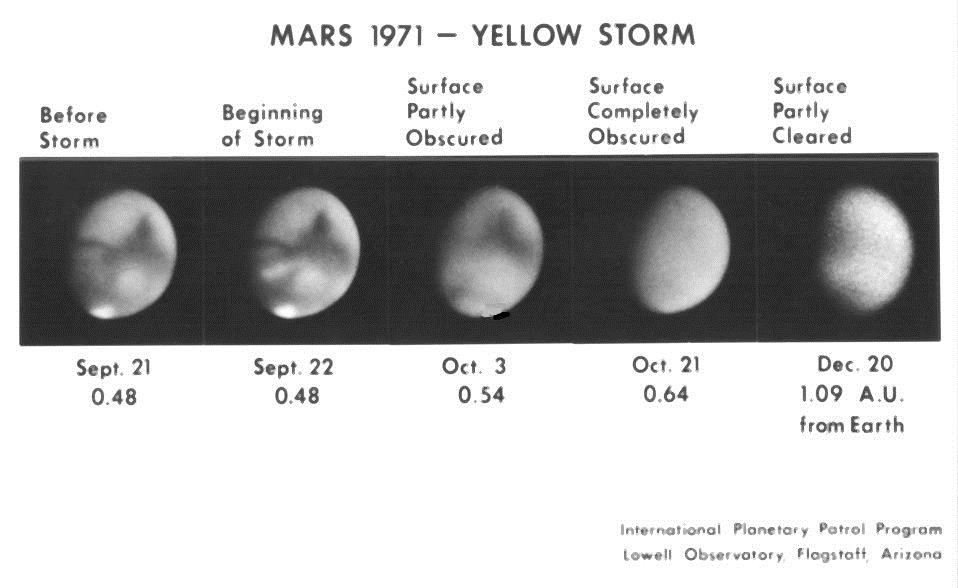
Figure 2. A sequence of photographs of the Great Dust Storm of 1971 composed by C. F. Capen. The "before storm" image was taken on Sept 21 (259° Ls). Dust clouds in Hellas and westward on Sept 22 (260° Ls), spreading in both directions by Oct 3 (267° Ls), Oct 21 (278° Ls), and begins to dissipate by Dec 20 (314° Ls). Hellas is light oval area south of Syrtis Major. Photographs taken by Lowell Observatory.
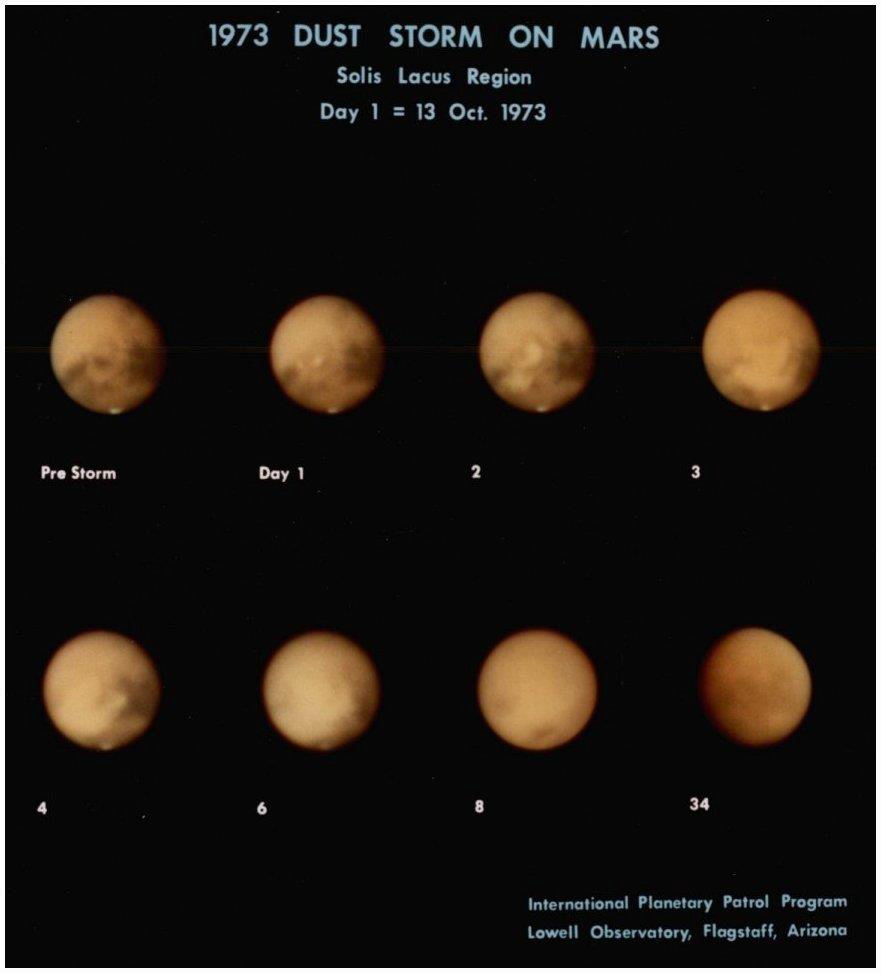
Figure 3. A sequence of photographs of the Great Dust Storm of 1973 composed by C. F. Capen. The "pre storm" image was taken Oct 13 (300° Ls). Bright dust cloud in Solis Lacus during "Day 1" on Oct 14 (301° Ls), increasing in size and a second dust cloud appears south of Solis Lacus in "Day 2" on Oct 15 (301° Ls), both dust clouds spread east and northeast in "Day 3" on Oct 16 (302° Ls), nearly blanks out 1/3rd of visible disk in "Day 4" on Oct 17 (302° Ls). In "Day 6" on Oct 19 (304° Ls) the dust storm is spreading north, east and west. Dust storm raging over much of the planet in "Day 8" on Oct 21 (305° Ls). "Day 34" on November xx, 1973 Mars begins to clear of planet-encircling dust storm for 1973. Hellas is light oval area south of Syrtis Major. Photographs taken by Lowell Observatory
Although the two dust storms of 1988
did not reach the "planet encircling" stage, similar
patterns emerged; during 206° Ls a major storm occurred,
followed by another major storm on 313° Ls
[Beish and Parker, 1988] and
[Beish and Parker, 1989].
Perhaps the statistical significance of the three periods above
appear to mislead us when attempting to predict when these
disturbances should occur. However, one should be especially
alert when observing Mars during these times -- even though we
have not passed through the first sensitive period as of yet, be
watchful in the next few weeks, alas, a major dust storm may be
lurking just around the corner!
HOW TO IDENTIFY DUST CLOUDS ON MARS
Mars observers frequently report "albedo features" lacking in contrast, the planet is "washed out," or Mars' atmosphere is "dusty." While such descriptions may have merit, generalized yellow hazes and temporary losses in surface contrast is usually omitted in our reports. Photographic evidence for these phenomena is also weak, since the proper sensitometric calibration is usually lacking.
Each apparition experienced Mars observers slowly grow familiar with the dark and light features on Mars with a regular systematic observing program. Those who regularly observe Mars during the early months of an apparition will develop the ability to recognize these features even without consulting Mars charts. An observer will then notice sudden changes in Mars’ features, such as a disappearance of a familiar feature or a bright area that was not there a few days before. You may just be seeing the beginnings of dust storm conditions. It is rare indeed when one can watch one of these great red clouds slowly move over the Martian landscape covering over features that were dark and well defined just hours before. Windstorms sometimes move the dust, resulting in both seasonal and long-term changes.
In the past we have referred to dust storms as "yellow clouds" and "yellow dust storms." We feel that this is misleading. First, it is virtually impossible to see or even photograph accurate colors on Mars without employing very specialized techniques. Traditionally, observers have employed yellow filters to better reveal dust clouds. The problem is that nearly every light feature on Mars is bright through a yellow filter! When the bright planet Mars is observed against a nighttime sky, the planet's predominantly orange or golden-ochre colored surface becomes highly saturated to the eye. This leads to confusion for the observer, as some features on Mars may appear to change colors during observations. Interestingly, the darker albedo features, when observed against this saturated background are sometimes perceived as complementary hues. This effect is known as "simultaneous contrast" [Hartmann, 1989]. Confusion over the colors of Mars is nothing new.
Dust clouds often appear bright yellow in the telescope without observing with filters. They are brightest in red light, but can be also bright in yellow light. Dust clouds will be blurry or hazy in yellow light. A blue filter will not brighten the dust cloud and often will make the dust cloud appear to vanish. However, we have found that yellow-white clouds can accompany dust clouds so the observer should watch for these phenomena. Look for a dusty polar cap following any dust clouds they show up in red and green light. Since Mars is red in color it will be brightest in red (W25 and W29) or orange filters (W21 and W23A). While observing Mars using a deep blue (W46 and W47B) or violet filter (W47) the surface features will most often disappear and only a dull bluish haze will been seen. Occasionally surface features will appear dark in deep blue light, a phenomenon not well understood.
Dust clouds are frequently confused with bright white areas, frosts, or localized fogs, and some dense white clouds. In addition, after identification is made, it becomes difficult to distinguish active dust clouds from fresh surface dust deposits. Such misinterpretation can make time studies difficult. It is interesting to note that prior to dust storms the atmosphere of Mars may appear devoid of bright clouds and limb hazes. In reviewing the characteristics of the Martian atmosphere for the same Martian season during previous apparitions, the authors were struck by the unusual clarity of Mars' sky in 1981-1982. Watch for Mars to undergo a drastic change before dust storm. Cloud and haze activity will pick up and the surface became ill defined. Limb clouds extended 30 to 40 degrees away from the limb. Topographic clouds were more numerous. It was as though Mars had experienced "the calm before the storm" so to speak.
Surface features in dusty regions appear "washed out" and ill defined compared to the clear and well-defined areas outside the immediate dusty area. Haze and bright clouds will usually cover both limbs with no indications of yellow color present in either the haze or clouds. Surface definition within the boundaries of the dust storm was of course reduced considerably. The storm appeared to be confined and displayed sharp boundaries throughout the duration of the observations. Even the polar regions can change after dust storms. The NPC or SPC may appear distinctly yellowish with a projecting cloud off the north or south limb. After dust clouds wane the "North or South Polar Cap" may still appear yellowish.
While working with the late Leonard Martin (Planetary Research Center, Lowell Observatory, Flagstaff, Arizona) and Richard W. Zurek (JPL) on problems of correctly identifying and classifying Martian dust clouds or storms, new guidelines have been established by the A.L.P.O. Mars Recorders for interpreting Martian dust clouds and dust storms, they are classified as:
The ALPO Mars Section has used for its criteria for identifying and cataloging dust clouds of Mars as adopted from Leonard J. Martin’s size classification for Martian dust storms. One can categorize them as follows: A local storm is one whose major axis does not exceed 2000 Km; a regional storm exceeds 2000 Km in at least one dimension but does not encircle the planet; and an encircling storm spans the circumference of Mars, usually covering both hemispheres. A global storm is an encircling event that covers the entire planet, including the poles [Beish and Parker, 1990] [Martin and Zurek, 1993].
Table I. Guidelines for interpreting
Martian dust clouds and dust storms.
|
|
| 1. White cloud or bright areas mistaken for dust cloud. |
| 2. Visual observation(s) of dust clouds in a dust storm. |
| 3. Instrumental observation(s) of dust cloud/storm (Includes photographic, polarimetric, spacecraft data, or other data obtained by instrumental means). |
|
|
| 1. Obscuration (obstruction)--Not sure if surface or atmospheric. |
| 2. Dust Haze--Partial obscuration with displacement. |
| 3. Bright dust cloud--Bright obscuration with displacements. |
| 4. Limb projection/terminator protrusion by dust cloud. |
|
|
| 1. Local--Dust storm with major axis not to exceed 2000 km (1,243 miles or less than 34 degrees). |
| 2. Regional--Dust storm with major axis that exceeds 2000 km (1,243 miles or less than 34 degrees) but not encircling either or both hemispheres. |
| 3. Planet Encircling--Dust storm with major axis that completely encircles either one or both hemispheres of Mars. |
Much has been written about the characteristics of these dust clouds and how to detect them. These dust clouds are very difficult to identify in their beginning stages and, in some cases, go undetected even after they have fully developed. As a general rule, a Martian dust cloud will qualify if they 1) are bright in red light, 2) show movement with obscuration of previously well-defined albedo features, and 3) may cast a shadow.
A general clockwise direction of motion of the yellow clouds and haze would suggest a cyclonic type disturbance in the southern hemisphere of Mars. Although the storm was located near the equator, a low-pressure zone within the dust storm can not be ruled out. Southern storms appear to expand in a clockwise direction from the Hellas-Yaonis areas and often winds its way around the southern globe and is seen on the southeast limb rendering Sirenum Mare completely invisible. Solis Lacus was barely visible during the period in integrated light but disappeared almost completely in yellow and green light. Some of these disturbances that have appeared on Mars is characteristic of the cyclonic cloud formations often observed on Earth.
On the other hand, some observers have confused bright Martian desert regions or bright fog areas with dust clouds. The bright orographic clouds (clouds over mountains) in Tharsis region of Mars may appear as dust clouds. The yellow-white appearance of some clouds most likely indicates the presence of dust particles; observers should not classify all bright clouds that appear to be yellowish as "dust clouds."
Several area on Mars exhibit a propensity for early dust storm development: dust streaks often begin in the northwest Hellas Basin across Serpentis-Noachis (320° W, 30° S), or in the "Eye of Mars" (the Solis Lacus region; 90° W, 30° S). Perhaps in the Chryse Basin (40° W, 10° N) [Beish, 1988]. The discovery of new dust-cloud sensitive areographic locations is most important to future Martian exploration missions. To detect dust clouds, use red, yellow, and magenta filters.
A Trend Analysis for Predicting Dust Storms on Mars
Numerous studies of the meteorology on Mars by the A.L.P.O. Mars Section has demonstrated that there are definite periods when we might expect to see a dust storm on Mars [Beish and Parker, 1986], [Beish and Parker, 1987], [Beish and Parker, 1990 and Beish, 1999]. These studies continued throughout the 1980’s and 1990’s and more evidence surfaced that confirms our hypnosis. We have found that the periods of dust event activity follows very closely to our earlier statistical analysis summarized in "Meteorology of Mars - Part III [Beish and Parker, 1987] [Beish, 1999]. As expected, major storms are often observed when Mars is closer to the Sun during Perihelic apparitions.
Our statistical analysis indicates that the number of dust clouds is more often observed from mid-southern summer, between 241° and 270° Ls, with a peak period at 255° Ls. This is substantiated by Viking space mission science studies on dust clouds indicating that most dust cloud activity occurs during southern spring and summer [Wells, 1979]. In the past, many of the major dust events occurred during the same seasonal period and led some researchers to refer to these major dust storms as "precursor storms prior to planet-encircling events." When a major dust event does occur during this period then we find that the highest probability of predicting planet-encircling dust storms occurs during mid-southern summer at or near 315° Ls [Beish, 1999].
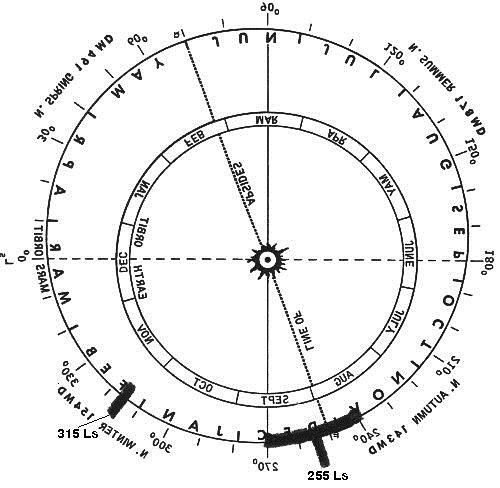
Figure 4. A Graphic Ephemera’s for the 2003 Perihelic Apparition of Mars with darken sectors indicating the seasonal periods for the probability of sighting a dust cloud or storm on Mars. The first period is from 241° Ls trough 270° Ls with a peak period occurring on 255° Ls. The second period is around 315° Ls. Original graph prepared by C.F. Capen and modified by J.D. Beish.
A recent survey by professional
researchers shows that dust events can occur during virtually any
season [Martin and Zurek, 1993]. Their paper
reinforces our study for a main peak period for dust events is
285° Ls (just after southern summer solstice) and a secondary
peak has been observed in early northern summer, around 105°
Ls. Their paper articulates our hypnosis that dust storms
occurring during southern summer are larger and more dramatic:
they can even grow rapidly to enshroud the whole
planet.
An exception to this was the 2001 planet-encircling storm that occurred at around 185 degrees Ls or 65 degrees before perihelion. This was the earliest major storm on record, and it surprised us because is started nearly two Martian "months" before the observed dusty "season" and four "months" before the high probability period of 315° Ls [Parker, 2001].
The Great Planet-Encircling Dust of 2001: An unusual planet-encircling dust storm was observed during the 2001 apparition of Mars and can be best described in the following Internet locations:
The 2001 global dust storm began on June 24, 2001 (183.5° Ls) in NW Hellas and major dust cloud activity ended on August 02, 2001 (206.4° Ls) while the atmosphere of Mars remained dusty for at least a month thereafter.Also, the British Astronomical Society Mars web page: http://www.britastro.org/mars/ then read the two PDF files by Richard McKim:
The opposition of Mars, 2001, Part I: http://alpo-j.sakura.ne.jp/kk01/JBAA119123-143McKim.pdf
and The opposition of Mars, 2001: Part II: https://britastro.org/node/11532
While observers were surprised by the planet-encircling storm that occurred in 2001 at around 184 degrees Ls or 66 degrees before perihelion, the 2018 apparition supplied us with a similar but more extensive spectacle with a global dust storm. Discovered by Efrain Morales Rivera (Aguadilla, Puerto Rico) using LX200ACF 12" telescope his May 31, 2018 (184.9° Ls ) at 0731UT image establishes the beginning as he captured a bright spot, in red and IR light, in Mare Acidarium-Niliacus Lacus. Several observers, John Boudreau and Joseph Rueck, followed with more evidence of a large dust cloud that divided and spread southward into eastern Chryse and Xanthe

Figure 6-40. First images of the 2018 global dust storm: Image-1: Efrain Morales Rivera, 2018-05-31, 0731UT, Ls=184.9°, CM=338.0°. Image-2: John Boudreau, 2018-05-31, 0852UT, Ls=184.9°, CM=357.7°. Image-3: Joseph Rueck, Ls=184.9°, CM=13.1°. Image-4: Efrain Morales Rivera, 2018-06-01, 0924UT, Ls=185.6°, CM=356.1°.
Soon the dust clouds expanded westward into Tharsis and encircled the globe of Mars across Syrtis Major and into Aeria-Moab and back to Chryse during early June. Several prominent areas on Mars are completely covered with dust, such as Meridiani Sinus, Margaritifer Sinus, Chryse, much of Niliacus Lacus and Aurorae Sinus - Agathodaemon - Ophir.

Figure 6-41. Three images from June 2 through June 7, 2018 by Isamu Hirabayashi shows dust clouds encircling the equatorial zone of Mars.
This will be a brief report of the 2018 global dust storm and more will follow as ALPO sorts out more reports and images. Apparently this storm was global because the entire globe, including both polar caps, was covered with a thick vial of dust by late-June and the storm may have peaked sometime on or about June 22, 2018. A dusty haze covered the entire planet throughout July, August and September 2018.
Following the excellent work by the Association of Lunar and Planetary Observers in Japan (ALPO-Japan) in their graphic charts of the dust storm progress: May 31, 2018 - June 22, 2018 for each image:
We now know what the early observers of Mars -- who never had the experience of witnessing a planet-encircling or global storm -- never imagined. Dust appears to be a major player in both short-and long-term climate changes on Mars. For that matter, it is probably more significant than it has hitherto been regarded on Earth; satellite images have recently shown plumes -- virtual rivers -- of dust transported by stratospheric winds from the Gobi desert across the Pacific over a matter of a few days. This was dramatically illustrated during the now classic Great Dust Storm of 2001 [Sheehan, 2003].
STATISTICAL METHOD
The statistical method is discussed here can be found in a paper that the ALPO Mars Section published in the Journal of Geophysical Research some years ago (Beish and Parker, 1990). Complex cyclical data can be used to forecast this trend analysis, or to plot a time series. The trend can be thought of as the average departure from the "mean." From an interesting concept taken from an old college outline (Longley-Cook, 1970) the methods discussed in this article was found in a chapter of the book on "Time Series." We applied this method to show the trends in observed cloud activity on Mars during a period from 1968 through 1985 [Beish, 2002]. This method is discussed in more detail in an article located at URL: https://alpo-astronomy.org/jbeish/MetTrendDust.htm
We then produced a plot of the time series trend line for dust clouds observed on Mars during eight apparitions and forecast an approximate number of clouds an observer is likely to see in future apparitions for a particular season. This study has been extended to include the 1965 apparition and the 1988, 1990, 1993, and 1995 apparitions. Using the first study to test the second time series model it was determined that a very close correlation exists between the two studies [Beish, 1999].
DUST CLOUDS IN THE POLAR REGIONS
Early in the 1997 apparition, at 11° Ls, images from the HST (See Figure 5) and from Parker (CCD) revealed dust streaks crossing the NPC [Parker, 1999].
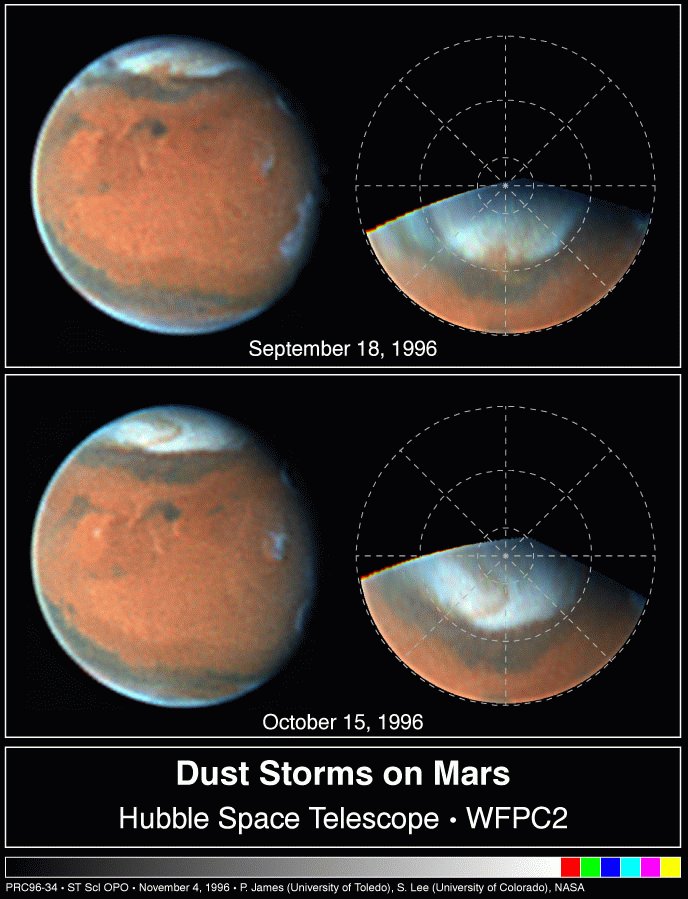
Other than this polar dust event, ground-based observers did not report any definite dust cloud activity during the apparition. There were sporadic reports of brightenings in Chryse, but these are fairly normal for the season and exhibited no characteristics of significant dust events. Chryse has been very bright at times in red light since the early 1980’s. At least some of this brightening may be due to evening and morning clouds injected with dust. The dust devil activity observed by the Pathfinder [Schofield et al., 1997] may be at least a partial source of this dust.Figure 5. Dust cloud/streak in north polar cap of Mars as imaged by the Hubble Space Telescope on September 18 and October 15, 1996.
Ground based telescopes were busy at work in 1999 when it caught a huge cyclone in the northern polar region. HST imaged this storm the next day (See Figure 6).
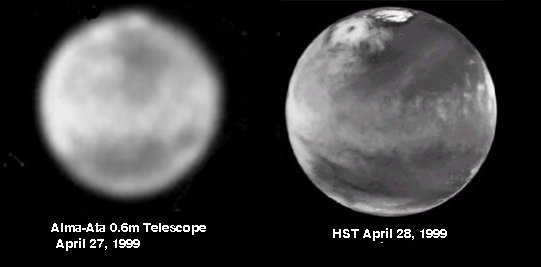
Figure 6. A cyclone disturbance near the north polar cap of Mars was discovered by the Alma-Ata 0.6-meter ground-based telescope on April 27, 1999 and imaged by the Hubble Space Telescope the following day (April 28). Along the edge of the polar cap, cyclonic disturbances are common during the late summer and fall. This storm system is located at the edge of the northern polar cap.
Mars observers have longed for a away to predict conditions that leads to the onset of dust storms. Since dust storms probably occur each year around the time of the summer solstice in the southern hemisphere we may safely predict the development of another dust storm, most likely in the Hellas-Noachis region, in July of 2003. This would be the first storm during the Martian southern spring and is what some refer to as the "precursor" storm that leads to the development of a second storm sometime later in the Mars year.
The Martian dusty period began on August 15, 2003 (241° Ls) and ended September 30, 2003 (270° Ls). During that period observers had the highest probability of seeing a dust cloud or maybe a major dust storm by September 6, 2003 (255° Ls) – however, we saw no major disturbances. This can be deceiving because in nature we find that accurate predictions are nearly impossible to make because of the complexities and unknown variables. So, once again the Red Planet cheated statisticians.
Writing in the May 1972 Sky and Telescope magazine, Charles F. ("Chick") Capen [Capen, 1972] gives us a clue in; "There is a remarkable similarity between the storms of 1956 and 1971. Before each one the Martian atmosphere displayed little or no white-cloud activity, and there was high contrast between familiar surface markings. Just before the storm's onset, the limb showed a light-yellow brightening. Both events began suddenly, within a single rotation of the planet, as a brilliant white streak over the Hel1espontus-Noachis region. Their initial dimensions and shapes were alike, though the 1971 cloud was always bigger and brighter."
Much more common is the "localized" dust event, often starting in desert regions near Serpentis-Noachis, Solis Lacus, Chryse, or Hellas. During the 1997 apparition, CCD and HST observations revealed localized dust clouds over the north polar cap early in northern spring [Troiani, et al, 1997], [Parker, et al, 1999]. The MGS MOC recorded two large dust clouds over Acidalium Mare and a smaller dust cloud over Syria-Claritas region just west of Solis Lacus. This dust system moved over parts of Thaumasia and Solis Laucs.
Also, as seen in Figures 5 and 6 above showing a dust swirl in the North Polar Cap (NPC) we also may have seen a similar dust swirl in the SPC. Just this morning, 01 July 2003 at 0840 – 1000 UT, two observers, Beish and Parker, have noticed what appears to be possible dust clouds south of Syrtis Major. Normally dark features from 270° W – 310° W, 15° S - 20° S appears to have changed dramatically since 30 June 2003 and is brighter now in orange (W23A filter) and blue-green (W64 filter) light. Areographic northwest Hellas (305° W, 20° S) brighter with a light spot that was not there on 30 June 2003. Light/bright streak from Pandorae Fretum into Iapygia Mare. Also, Tyrrhenum Mare, Cimmerium Mare lighter than on 30 June 2003 and Hesperia not as well-defined. While Zea Lacus was seen by Beish the "canal" Peneus that connects from Yoanis Fr. to Zea Lacus was gone on 01 July 2003.
Observers should continue to watch for dust storms because there is still a chance of major disturbances no later than mid-December (315° Ls) if Mars' windy season follows a more normal course of behavior. A check into dust activity that spacecraft record check the Malin Space Science Systems Home Page dust events archives at: http://www.msss.com/msss_images/subject/dust_storms.html.
Hubble Space Telescope (HST) press release "Seasonal dates of great martian dust storms (1894-1982)," describes when dust storms occur on Mars: https://www.spacetelescope.org/images/opo0131l/. and there is evidence that dust storm may effect atmospheric pressure on Mars can be found in this study: http://www-k12.atmos.washington.edu/k12/resources/mars_data-information/data.html. At Viking Lander-2 the pressure peaked at 9.57 mB on October 05, 1977 at 1722 UT (Ls 344.5°) and again at 9.42 mB on October 05, 1977 at 1411 UT (Ls 344.5°). Then at Viking Lander-1 the pressure peaked at 10.72 mB on June 09, 1982 at 2219 UT (Ls 138.7°) and again at 10.72 mB on June 15, 1982 at 0021 UT (Ls 141.3°).

NOTE: Viking-1 was launched on August 20, 1975 and began orbiting Mars on June 19, 1976 (9m 29d) and the Lander-1 landed in the Chryse Planitia (22.3°, 312.1°) on July 20, 1976 (Ls 96.8°) and lasted until November 11, 1982 (Ls 225.3°). Viking-2 was launched on September 09, 1975 and began orbiting Mars on August 07, 1976 (10m 26d). Lander-2 landed in Utopia Planitia (47.6°, 134.3°) on September 03, 1976 (Ls 117.2°) and lasted until April 12, 1980 (Ls 91.5°).
REFERENCES
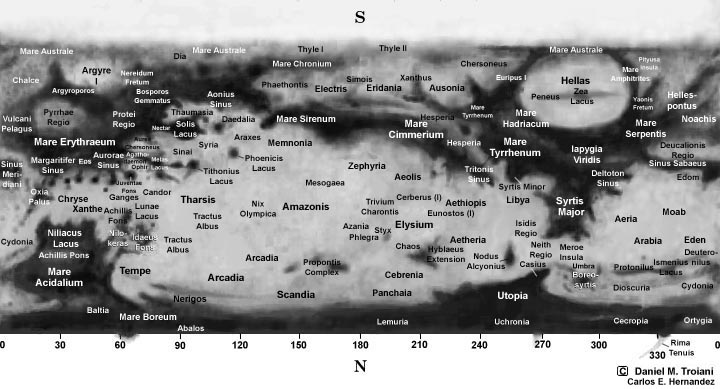
Beish, J.D., Parker, D.C., and Capen, C.F. (1986), "Meteorology of Mars - Part I," Journal of the Association of Lunar and Planetary Observers (J.A.L.P.O.), Vol. 31, Nos. 11-12, November.
Beish, J.D., Parker, D.C., and Capen, C.F. (1987), "Meteorology of Mars - Part II," J.A.L.P.O., Vol. 32, Nos. 1-2, March.
Beish, J.D. and Parker, D.C. (1987) , "Meteorology of Mars - Part III," J.A.L.P.O., Vol 32, Nos. 5-6, October.
Beish, J.D., Parker, DC, Eicher, D. (1988), "Dust Storms Observed On Mars," Astronomy Magazine, Vol. 16, No. 9, September.
Beish, J.D., Parker, D.C., and Hernandez, C.E., (1989,) "The Red Planet Shows Off", Sky and Telescope Magazine, Vol. 77, No. 1, pp. 30-35, January.
Beish, J.D., and D.C. Parker (1990). "Meteorological Survey of Mars, 1968-1985," Journal of Geophysical Research (JGR), Vol. 95, B9, pp. 14567-14675. August 20.
Beish, J.D. (1999), "Meteorological Survey of Mars For Opposition Years 1965 - 1995," The ALPO Computing section Web Page: The Digital Lens, November. http://www.m2c3.com/alpocs/tdl1999/meterological110199/MOM.html
Beish, J.D. (2002), "A
Trend Analysis for Predicting Cloudy Periods on Mars,"
ALPO Internet Web Page: The Mars Section, June
2002.
MetTrend.htm
Bradbury, Ray, (1950), The Martian Chronicles, Chapter November 2005: The Off Season, pp. 132 – 143, Doubleday, Bantam Books, 1985.
Capen and Martin (1971), "The Development Stages of the Martian Yellow Storm of 1971," Lowell Observatory Bulletin No. 157, November.
Capen and Martin (1972), "Mars’ Great Storm of 1971," Sky and telescope Magazine, Vol. 41, No. 2, May.
Capen and Martin (1972), "Survey of Martian Yellow Storms," Bulletin of the American Astronomical Society, Vol. 4, No. 3, Part III, March.
Hartmann, W. K. (1989), "What's New on Mars?" Sky and Telescope Magazine, Vol. 77, No. 5, page 474 [inset "Mars from Mauna Kea"] , May.
Houben, Howard, "A Global Martian Dust Storm Model," Proceedings; Third International Colloquium on Mars, Pasadena, CA August 331 – September 2, 1981, pp117.
Longley-Cook, L.H. (1970), "Chap. 9: Time Series," Statistical Problems and How to Solve Them, Barnes and Nobles, New York, pp. 173-201.
Kahn, R.A., T.Z. Martin, R.W. Zurek, and S.W. Lee (1992), "Chapter 29: The Martian Dust Cycle," Mars, U.of AZ Press, pp. 1017-1044
Lee, S.W. (1985), "Influence of Atmospheric Dust Loading and Water Vapor Content on settling Velocities of Martian Dust/Ice Grains," MECA Workshop on Dust on Mars II, LPI Tech. Report 85-02, pp 51-52.
Martin, L.J. (1974), "The Major Dust Storms of 1971 and 1973," ICARUS, 23, 108-115.
Martin, L.J. (1984), "Clearing the Martian Air: The Troubled History of Dust Storms", ICARUS, Vol. 57, 313-321, 1984.
Martin, L. J. and R. W. Zurek (1993), "An Analysis of the History of Dust Activity on Mars." Journal of Geophysical Research (JGR), Vol. 98, no. E2, pp. 3221-3246.
McKim, R. (1999)., "Telescopic Martian Dust Storms: A Narrative and Catalogue," Memoires of the British Astronomical Association, Vol. 44, June 1999
McKim, R. (2008). " The opposition of Mars, 2001: Part I." Journal of the British Astronomical Association, Vol. 119, no. 3. http://alpo-j.asahikawa-med.ac.jp/kk01/JBAA119123-143McKim.pdf
McKim, R. (2017). "Mars in 2001 - Second interim report" Journal of the British Astronomical Association, https://britastro.org/node/11532
Parker, D.C., J.D. Beish, D. M. Troiani, D. P. Joyce, and C. E. Hernandez (1999), "Telescopic Observations of Mars, 1996-1997: Results of the Marswatch Program," ICARUS, Vol. 138, No. 1, March, P.3.
Parker, D.C. (2001), "The 2001 Martian Dust Storm," Sky and Telescope Magazine, Vol. 103, No. 6, December, pp. 117.
Pollack, J.B. (1989), "The General Circulation of the Martian Atmosphere," Proceedings; Fourth International Colloquium on Mars, Tucson, AZ, January 10-13, pp. 48.
Schofield, J. T., J. R. Barnes, D. Crisp, R. M. Haberle, S. Larsen, J. A. Magalhaes, J. R. Murphy, A. Seiff, and G. Wilson 1997. The Mars Pathfinder atmospheric structure investigation/ meteorology (ASI/MET) experiment, Science, 278, 1752-1758.
Sheehan, William (2003), excerpts from article with collaborating ALPO Mars Section authors to be published in the near future.
Tillman, James E. (1988), "Mars Global Atmospheric Oscillations: Annually Synchronized, Transient Normal-Mode Oscillations and the Triggering of Global Dust Storms," Journal of Geophysical Research (JGR), Vol. 93, No. D8, pp. 9433-9451, August.
Tillman, James E. (1997), "Mars," July 04, 1997, http://www-k12.atmos.washington.edu/k12/resources/mars_data-information/data.html
Troiani, D.M., D.P. Joyce, D. C. Parker, C. E. Hernandez, and J.D. Beish (1997), "Telescopic Observations of Mars, 1996-1997: Results of the MarsWatch Program¾ I: Surface and Dust," Second Mars Telescopic Observations Workshop, Tucson, AZ, October 2-3.
Wells, R.A. (1979), "1.3.3 Yellow Clouds: Dust Particles from the Surface," Geophysics of Mars, Elsevier Scientific Publishing Company, New York, ISDN 0-444-4 1802-4, Vol. 4), pp.90 – 95.
Zurek, R. W. (1989) ,
"Dust in the Martian Atmosphere," Proceedings;
Fourth International Colloquium on Mars, Tucson, AZ,
January 10-13, pp. 57.